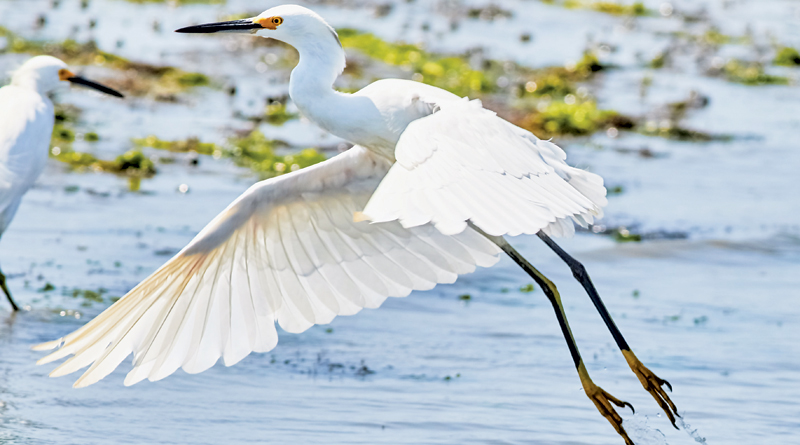CRANES BY THE THOUSAND – Life In The Outdoors

In “A Field Guide to the Birds” Roger Tory Peterson described the sandhill crane as “a long-legged, long-necked gray bird with a bald red forehead.” Standing, a sandhill crane is over five feet tall. Peterson described the great blue heron as similarly sized but a great blue heron flies “with its head drawn back on its shoulders, while a Crane flies with neck extended and legs trailing, ‘like a flying cross.”
Peterson did not give the range of the sandhill crane but a later book I have lists it as breeding from the northern tundra south into the northern states of the U.S., and on other flat lands, presumably marshy grasslands, where grasslands still existed, even in Iowa where I lived as a boy. But I never saw a sandhill crane, or a whooping crane, another species of crane of North America, though both sandhill cranes and whooping cranes are supposed to nest in Iowa. But I have never seen a crane in Iowa.
I never saw a crane, any crane, anywhere, until I moved to Indiana. There, the day after I moved to Indiana, I saw two sandhill cranes at the Jasper-Pulaski Fish and Wildlife Area, J-P, my first place of employment in Indiana.
Many species of bird, most species, have been declining in number in recent years. The overall number of birds has declined
by an estimated two-thirds. But a few species have been increasing and one species that has been increasing is the sandhill crane. I now see one, or more often two, flying not only in late fall when they are migrating, flying south, but any time of year. I’ve seen two sandhill cranes flying over our home in the country. I’ve seen two sandhill cranes on the ground, standing, even in our pasture. I’ve had people tell me of sandhill cranes nesting in Indiana, in fields, some close to my home.
I get a thrill every time I see a crane but I get the greatest thrill when thousands, in the air and on the ground, as I do when I visit J-P, which I do every year late in the fall. There are sandhill cranes at J-P year-round now but in late fall the number is augmented by migrants. My older daughter and I went to J-P a week ago. We went to a place at J-P called the goose pasture. On one side of the goose pasture is a raised platform for observers.
At the goose pasture we saw thousands of sandhill cranes, in the air and on the ground. Employees are stationed around the perimeter of the property in fall once a week to count the cranes flying in at dusk. This weekly count was begun many years ago, well before I moved to J-P. While I was there I participated in the weekly crane counts.
The peak numbers of annual fall counts of sandhill cranes at J-P are astounding. In 1935, presumably the year the counts began, the peak was 35. In 1944 the peak was 700, in 1956, 1,800, in 1973, 4,000, in 1978, 13,000 and a few years later, 32,000. I didn’t see anybody who works at J-P when my daughter and I visited this year but the peak will be in the hundreds of thousands I’m sure.
We saw sandhill cranes at J-P, particularly at the goose pasture, in the air and on the ground, and for miles around J-P, everywhere we drove in and around J-P. We saw two whooping cranes also.
Whooping cranes are great white birds with black wing tips. They are inches taller even than sandhill cranes. They nest in a small area of the tundra in northern Canada. Whoopers, as these cranes are often called, have not increased like sandhill cranes have. To see a whooper is a special treat.
- Birds As Weather Forecasters – Life In The Outdoors - December 17, 2021
- Rare Bird Spotted In Indiana – Life In The Outdoors - October 8, 2021
- MY EXPERIENCE WITH DEER – Life In The Outdoors - July 30, 2021


